Numerical Investigation on the Mechanism of Transpiration Cooling for Porous Struts Based on Local Thermal Non-Equilibrium Model
Abstract
:1. Introduction
2. Simulation Method
2.1. Geometry Model and Boundary Conditions
2.2. Governing Equations
2.3. Numerical Mesh and Method
2.3.1. Numerical Mesh
2.3.2. Numerical Method
2.3.3. Numerical Validation
3. Results and Discussion
3.1. Mechanism of Transpiration Cooling for Strut
3.2. Influence of Coolant Mass Flow Rate on Transpiration Cooling
3.3. Influence of Various Coolants on Transpiration Cooling
4. Conclusions
- In the process of transpiration cooling, the coolant with low temperature flows through porous medium, forming a film on the surface of strut and making the velocity boundary layer thicker, which effectively protect the strut. The bow shock wave is pushed away from strut, reducing the heat and force load exerted on the leading edge of strut.
- The temperature difference between fluid and solid inside the porous medium is analyzed and the phenomenon that fluid temperature is higher than solid temperature at the leading edge inside the strut is observed and explained. Density of fluid is far lower than that of solid, so the total mass of fluid is far less than that of solid in a certain volume of porous medium. Though the specific heat of fluid is larger, the fluid temperature rises higher when absorbing same quantity of heat.
- As the mass flow rate of coolant increases, the heat transfer between fluid and solid in the porous medium is enhanced, so that the fluid and solid temperature can early reach the balance and the temperature difference is smaller at both the inlet and outlet of the coolant. Besides, the solid temperature at the leading edge of porous strut and coolant mass flow rates show a power function, and when the coolant flow rate reaches a certain level, further increasing the flow rate will not bring an obvious improvement on cooling effect.
- The density and specific heat of coolant are two factors that influence the effect of transpiration cooling. When using a low-density coolant, the injection velocity to the main flow is larger, which brings more obvious blow effect on the mainstream and pushes the shock wave farther away from the stagnation point, providing a better cooling effect. The coolant with higher specific heat has a better heat absorption capacity, resulting a stronger dynamic equilibrium between the fluid and solid inside the porous medium.
Author Contributions
Funding
Institutional Review Board Statement
Informed Consent Statement
Data Availability Statement
Conflicts of Interest
Nomenclature
| Latin | |
| Afs | Specific surface area of porous media: [m−1] |
| dp | Particle diameter, [μm] |
| E | Total energy, [J/kg] |
| F | Inertia coefficient |
| hfs | Heat transfer coefficient between fluid and solid in porous media, [W/m2·K] |
| K | Permeability of porous media, [m2] |
| Kn | Knudsen number |
| L | Total length of strut, [mm] |
| Mass flow rate, [kg/s] | |
| Ma | Mach number |
| Nufs | Nusselt number in porous media |
| p | Pressure, [Pa] |
| Pr | Prandtl number |
| Re | Reynolds number |
| T | Temperature, [K] |
| V | Velocity, [m/s] |
| Greek | |
| ε | Porosity of porous media |
| μ | Dynamic viscosity, [Pa·s] |
| ρ | Density, [kg/m3] |
| τ | Shear stress tensor, [Pa] |
| Subscripts | |
| coolant | Coolant |
| f | Fluid |
| r | Recovery |
| s | Solid |
| Abbreviations | |
| LTE | Local Thermal Equilibrium |
| LTNE | Local Thermal Non-Equilibrium |
| UDF | User-Defined Function |
References
- Gerlinger, P.; Stoll, P.; Kindler, M.; Schneider, F.; Aigner, M. Numerical investigation of mixing and combustion enhancement in supersonic combustors by strut induced streamwise vorticity. Aerosp. Sci. Technol. 2008, 12, 159–168. [Google Scholar] [CrossRef] [Green Version]
- Pandey, K.M.; Roga, S.; Choubey, G. Computational Analysis of Hypersonic Combustor Using Strut Injector at Flight Mach 7. Combust. Sci. Technol. 2015, 187, 1392–1407. [Google Scholar] [CrossRef]
- Tani, K.; Kanda, T.; Kudou, K. Aerodynamic Performance of Scramjet Inlet Models with a Single Strut. J. Propul. Power 2006, 22, 905–912. [Google Scholar] [CrossRef]
- Desikan, S.L.N.; Kurian, J. Mixing Studies in Supersonic Flow Employing Strut Based Hypermixers. In Proceedings of the 41st AIAA/ASME/SAE/ASEE Joint Propulsion Conference & Exhibit, Tucson, AZ, USA, 10–13 July 2005. [Google Scholar]
- Bouchez, M.; Saunier, E.; Peres, P.; Lansalot, J. Advanced carbon/carbon injection strut for actual scramjet. In Proceedings of the Space Plane and Hypersonic Systems and Technology Conference, Norfolk, VA, USA, 18–22 November 1996. [Google Scholar]
- Jiang, P.; Huang, G.; Zhu, Y.; Liao, Z.; Huang, Z. Experimental investigation of combined transpiration and film cooling for sintered metal porous struts. Int. J. Heat Mass Transf. 2017, 108, 232–243. [Google Scholar] [CrossRef]
- Xiao, X.; Zhao, G.; Zhou, W. Numerical investigation of transpiration cooling for porous nose cone with liquid coolant. Int. J. Heat Mass Transf. 2018, 121, 1297–1306. [Google Scholar] [CrossRef]
- Herbertz, A.; Ortelt, M.; Müller, I.; Hald, H. Transpiration Cooled Ceramic Thrust Chamber Applicability for High-Thrust Rocket Engines. In Proceedings of the 48th AIAA/ASME/SAE/ASEE Joint Propulsion Conference & Exhibit, Atlanta, GA, USA, 30 July–1 August 2012. [Google Scholar]
- Zhu, Y.; Jiang, P.; Sun, J.; Xiong, Y. Injector Head Transpiration Cooling Coupled with Combustion in H2/O2 Subscale Thrust Chamber. J. Thermophys. Heat Transf. 2013, 27, 42–51. [Google Scholar] [CrossRef]
- Wang, J.; Messner, J.; Stetter, H. An Experimental Investigation on Transpiration Cooling Part II: Comparison of Cooling Methods and Media. Int. J. Rotating Mach. 2004, 10, 355–363. [Google Scholar] [CrossRef]
- Xu, G.; Liu, Y.; Luo, X.; Ma, J.; Li, H. Experimental investigation of transpiration cooling for sintered woven wire mesh structures. Int. J. Heat Mass Transf. 2015, 91, 898–907. [Google Scholar] [CrossRef]
- Haidn, O.; Greuel, D.; Herbertz, A.; Ortelt, M.; Hald, H. Transpiration Cooling Appllied to C/C Liners of Cryogenic Liquid Rocket Engines. In Proceedings of the 40th AIAA/ASME/SAE/ASEE Joint Propulsion Conference & Exhibit, Fort Lauderdale, FL, USA, 11–14 July 2004. [Google Scholar]
- Qian, K.; Wang, J.; He, F.; Wu, Y.; Zhou, Z. An experimental investigation on transpiration cooling performances using solid hydrogel as coolant. Appl. Therm. Eng. 2019, 158, 113753. [Google Scholar] [CrossRef]
- Wu, N.; Wang, J.; Dong, W.; Ding, R. An experimental investigation on combined sublimation and transpiration cooling for sintered porous plates. Int. J. Heat Mass Transf. 2018, 116, 685–693. [Google Scholar] [CrossRef]
- van Foreest, A.; Sippel, M.; Gülhan, A.; Esser, B.; Ambrosius, B.A.C.; Sudmeijer, K. Transpiration Cooling Using Liquid Water. J. Thermophys. Heat Transf. 2009, 23, 693–702. [Google Scholar] [CrossRef]
- Shen, L.; Wang, J.; Dong, W.; Pu, J.; Peng, J.; Qu, D.; Chen, L. An experimental investigation on transpiration cooling with phase change under supersonic condition. Appl. Therm. Eng. 2016, 105, 549–556. [Google Scholar] [CrossRef]
- Zhao, L.; Wang, J.; Ma, J.; Lin, J.; Peng, J.; Qu, D.; Chen, L. An experimental investigation on transpiration cooling under supersonic condition using a nose cone model. Int. J. Therm. Sci. 2014, 84, 207–213. [Google Scholar] [CrossRef]
- Huang, G.; Zhu, Y.; Liao, Z.; Lu, T.; Jiang, P.; Huang, Z. Experimental Study on Combined Cooling Method for Porous Struts in Supersonic Flow. J. Heat Transf. 2018, 140, 022201. [Google Scholar] [CrossRef]
- Prokein, D.; von Wolfersdorf, J. Numerical simulation of turbulent boundary layers with foreign gas transpiration using OpenFOAM. Acta Astronaut. 2019, 158, 253–263. [Google Scholar] [CrossRef]
- Langener, T.; von Wolfersdorf, J.; Steelant, J. Experimental Investigations on Transpiration Cooling for Scramjet Applications Using Different Coolants. AIAA J. 2011, 49, 1409–1419. [Google Scholar] [CrossRef]
- Jiang, P.; Lu, X. Numerical simulation of fluid flow and convection heat transfer in sintered porous plate channels. Int. J. Heat Mass Transf. 2006, 49, 1685–1695. [Google Scholar] [CrossRef]
- Ding, R.; Wang, J.; He, F.; Wang, M.; Luan, Y.; Dong, G.; Tang, L. Numerical investigation on a double layer combined cooling structure for aerodynamic heat control of hypersonic vehicle leading edge. Appl. Therm. Eng. 2020, 169, 114949. [Google Scholar] [CrossRef]
- Huang, Z.; Zhu, Y.; Jiang, P.; Xiong, Y. Investigation of a Porous Transpiration-Cooled Strut Injector. J. Propul. Power 2015, 31, 278–285. [Google Scholar] [CrossRef]
- Huang, Z.; Zhu, Y.; Xiong, Y.; Jiang, P. Investigation of transpiration cooling for sintered metal porous struts in supersonic flow. Appl. Therm. Eng. 2014, 70, 240–249. [Google Scholar] [CrossRef]
- Xiong, Y.; Zhu, Y.; Jiang, P. Numerical Simulation of Transpiration Cooling for Sintered Metal Porous Strut of the Scramjet Combustion Chamber. Heat Transf. Eng. 2013, 35, 721–729. [Google Scholar] [CrossRef]
- Wang, J.; Wang, H. A Discussion of Transpiration Cooling Problems through an Analytical Solution of Local Thermal Nonequilibrium Model. J. Heat Transf. 2006, 128, 1093–1098. [Google Scholar] [CrossRef]
- Shi, J.; Wang, J. A Numerical Investigation of Transpiration Cooling with Liquid Coolant Phase Change. Transp. Porous Media 2011, 87, 703–716. [Google Scholar] [CrossRef]
- Lee, S.L.; Yang, J. Modeling of Darcy-Forchheimer drag for fluid flow across a bank of circular cylinders. Int. J. Heat Mass Transf. 1997, 40, 3149–3155. [Google Scholar] [CrossRef]
- Jiang, P.; Ren, Z. Numerical investigation of forced convection heat transfer in porous media using a thermal non-equilibrium model. Int. J. Heat Fluid Flow 2001, 22, 102–110. [Google Scholar] [CrossRef]
- Xu, R.; Huang, Y.; Jiang, P.; Wang, B. Internal heat transfer coefficients in microporous media with rarefaction effects. Sci. China Technol. Sci. 2012, 55, 2869–2876. [Google Scholar] [CrossRef]
- Langener, T.; von Wolfersdorf, J.; Kuhn, M.; Steelant, J. Transpiration Cooling with Supersonic Flows and Foreign Gas Injection. In Proceedings of the 46th AIAA/ASME/SAE/ASEE Joint Propulsion Conference & Exhibit, Nashville, TN, USA, 25–28 July 2010. [Google Scholar]

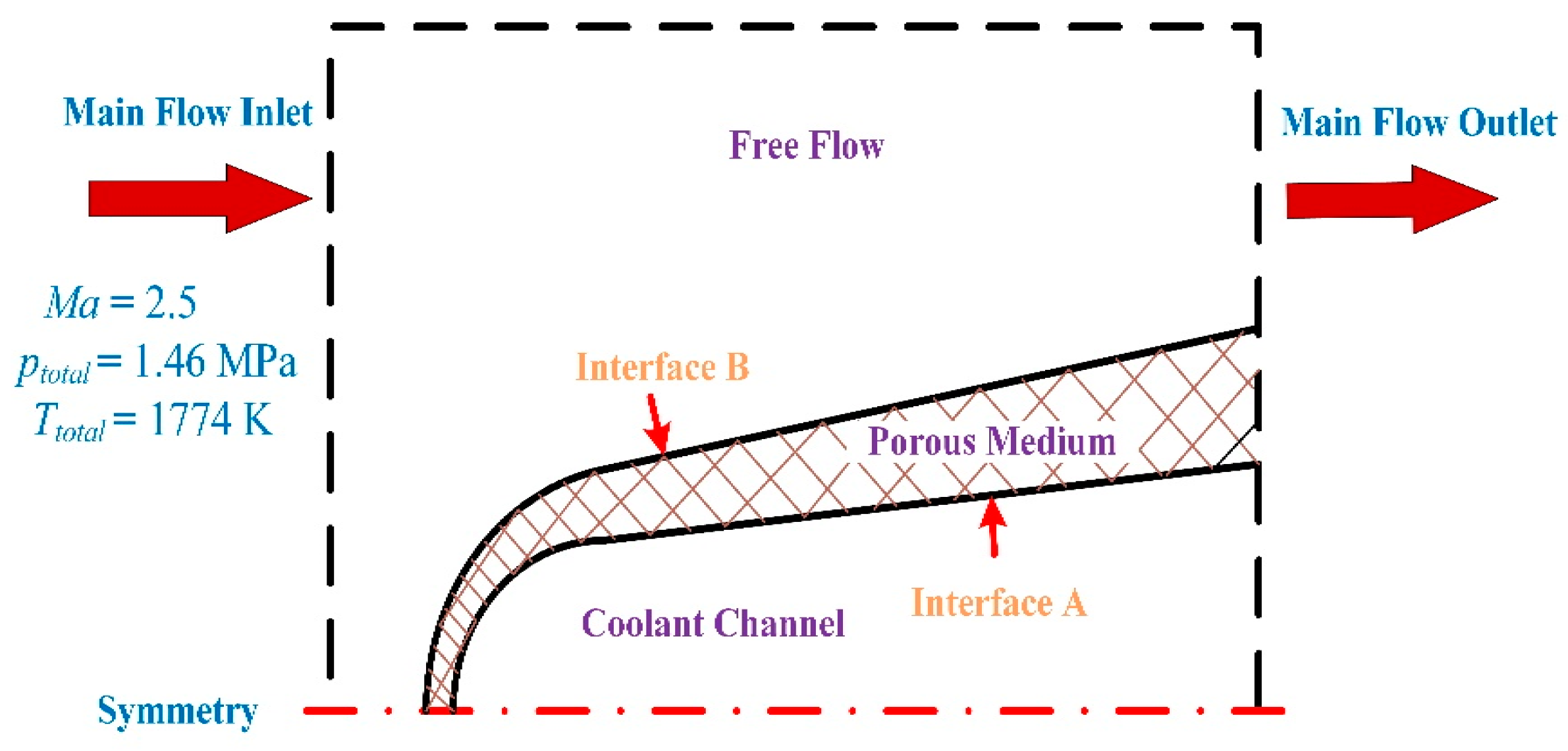
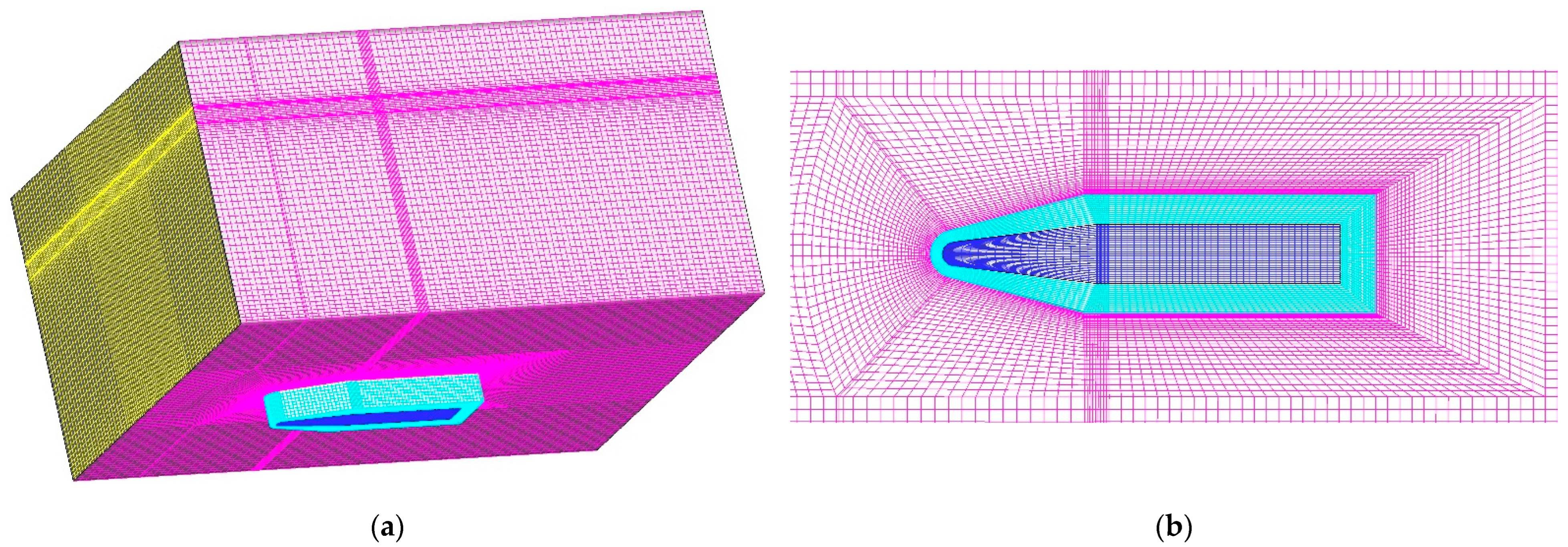

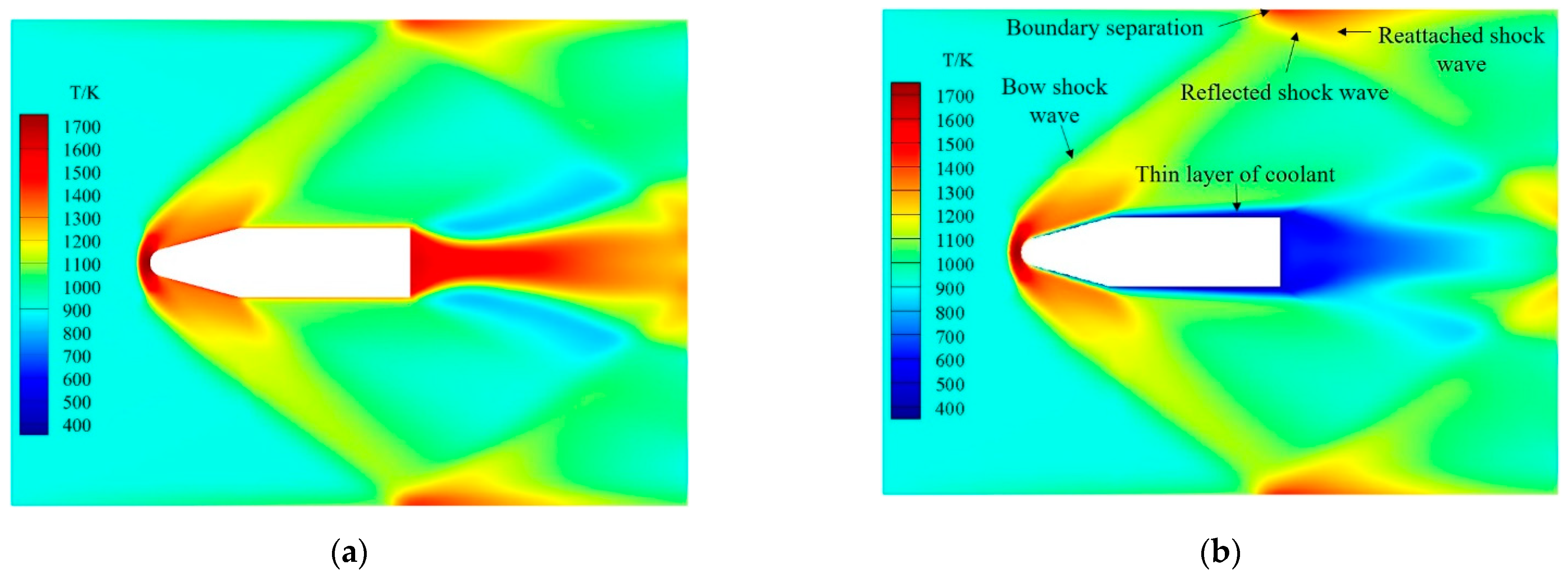


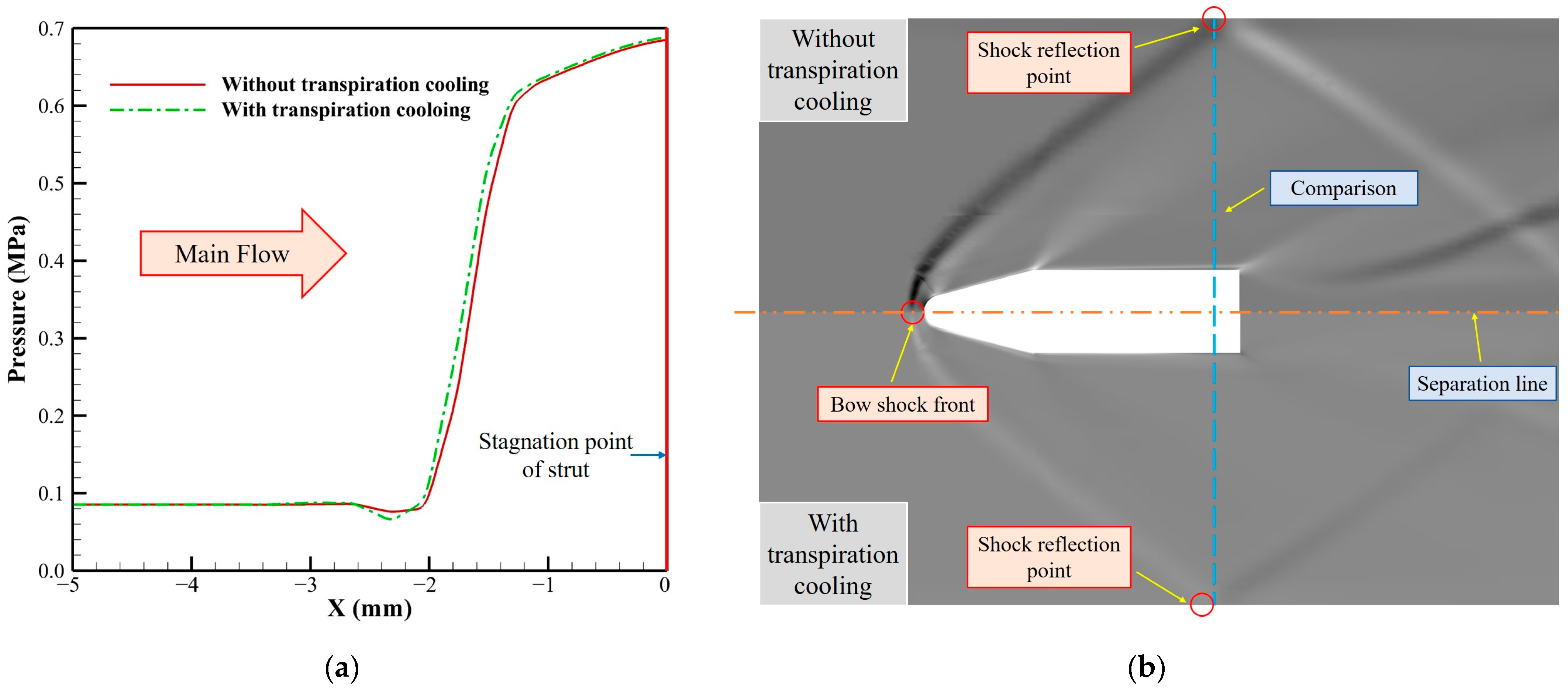
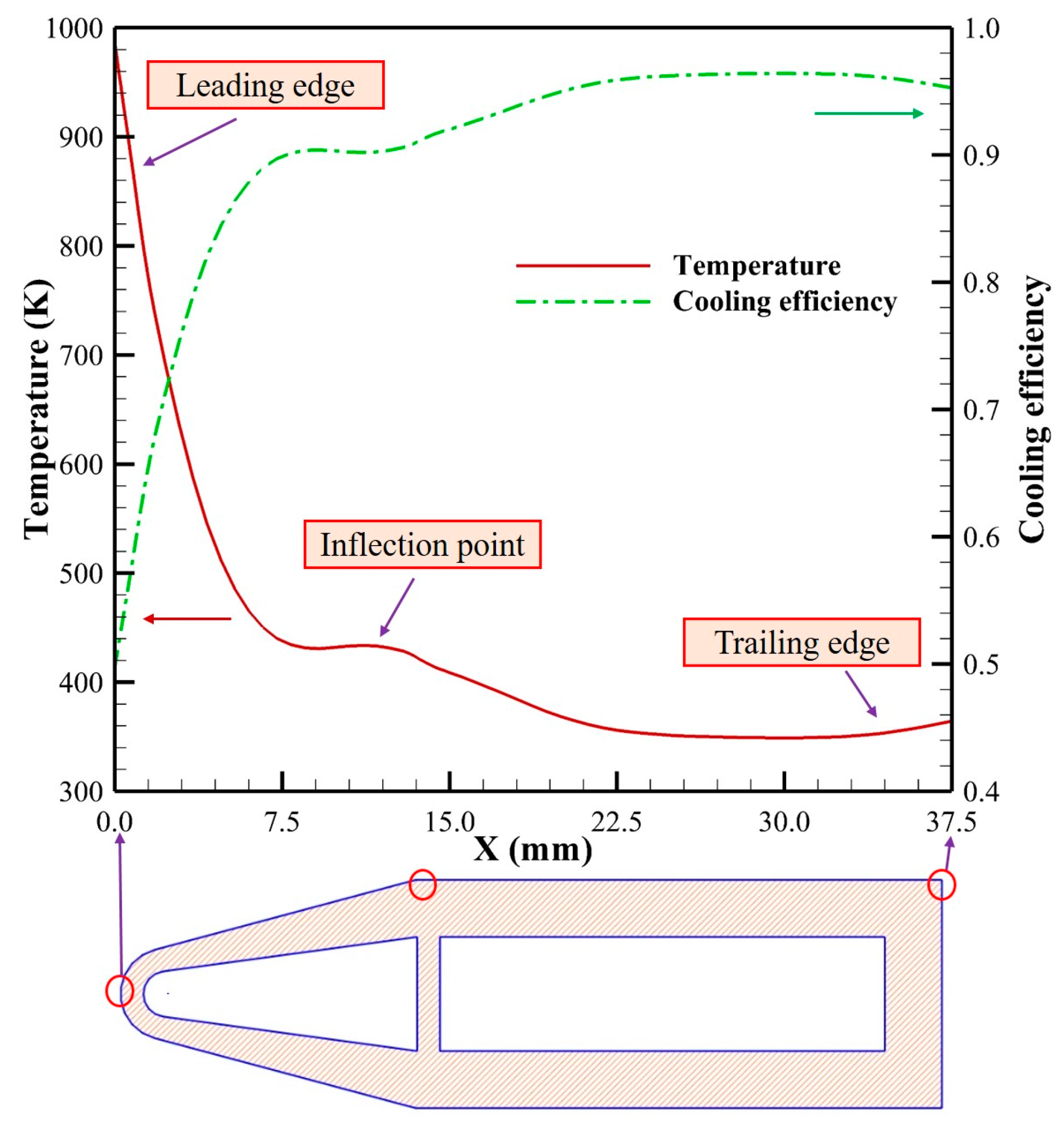
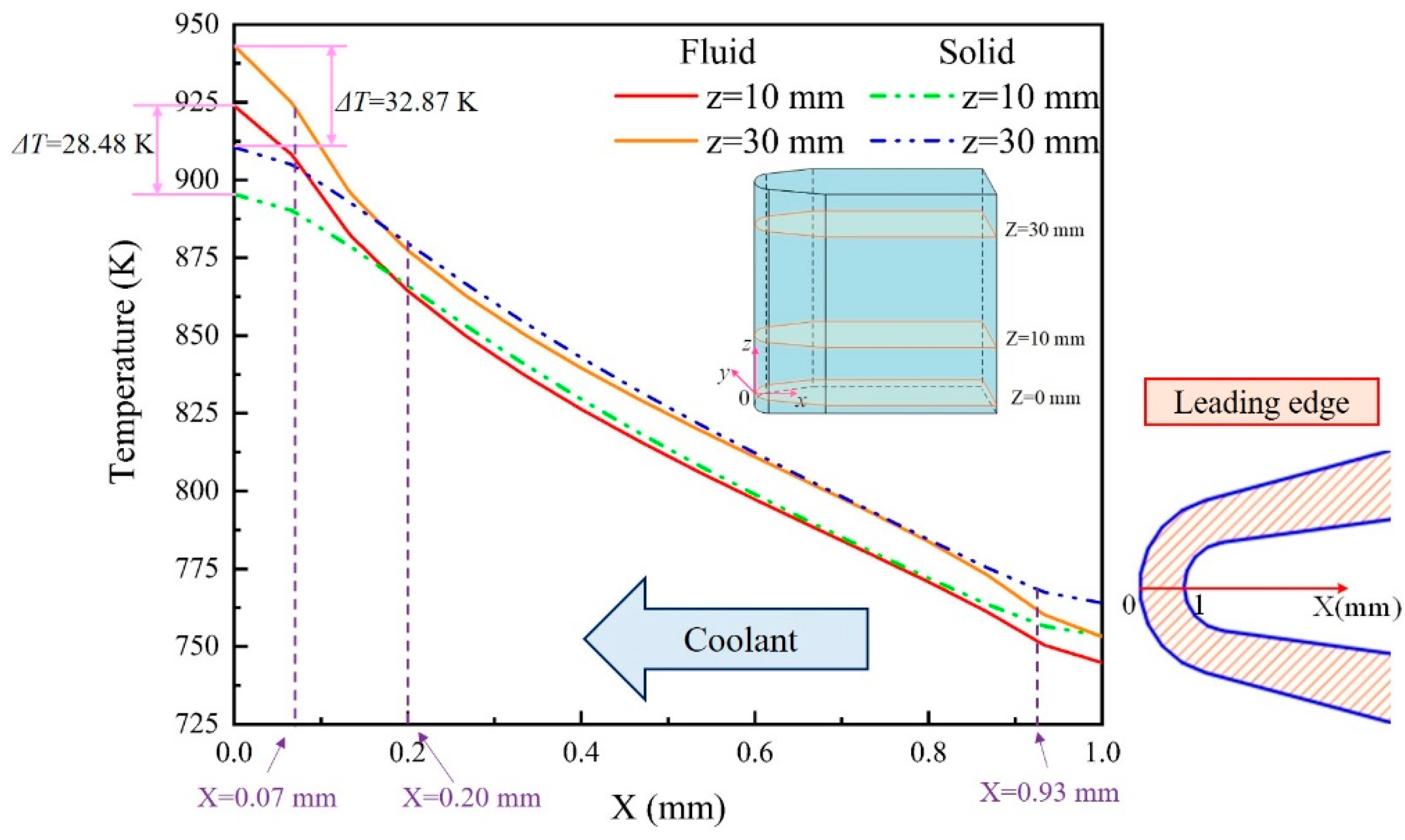
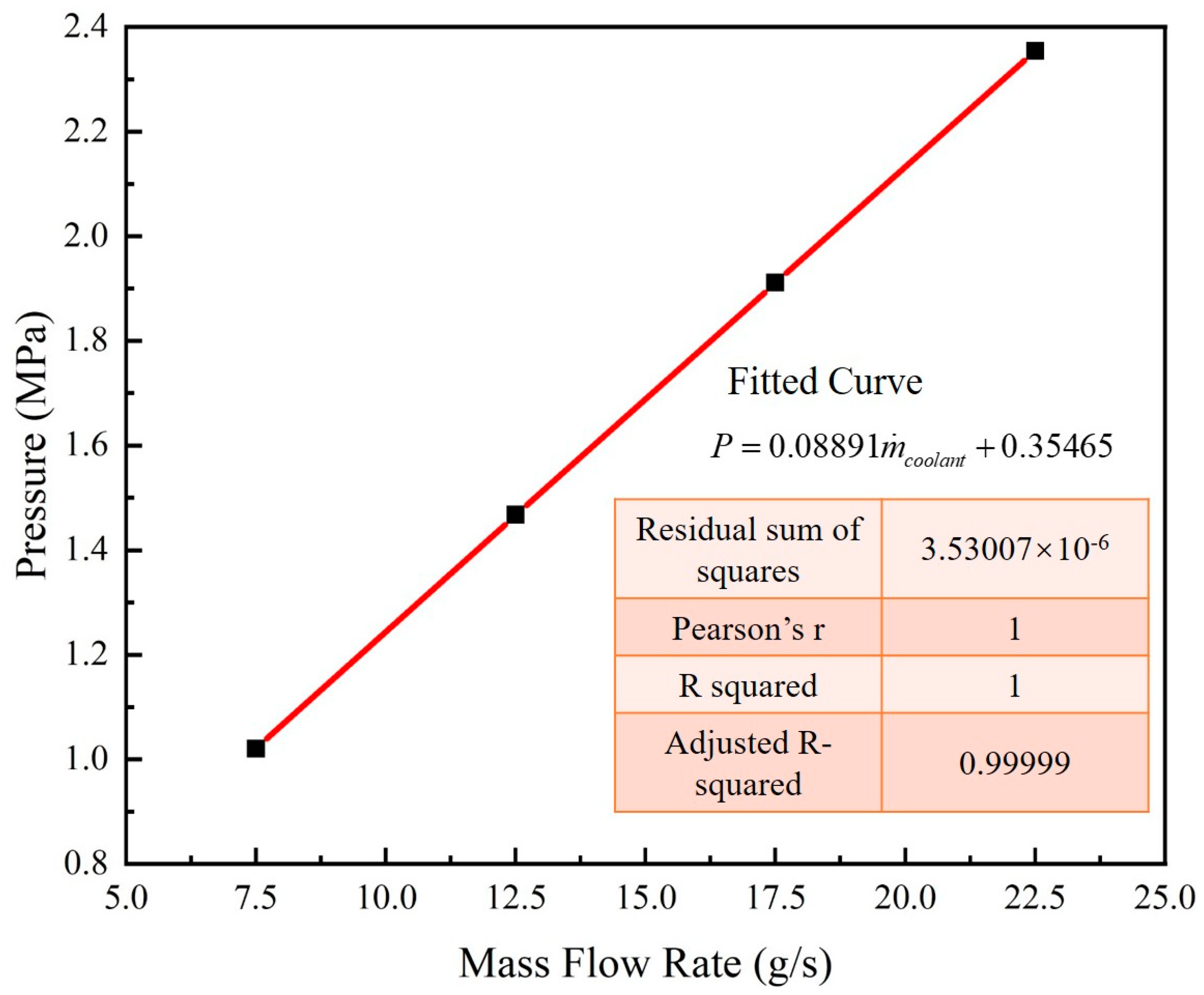
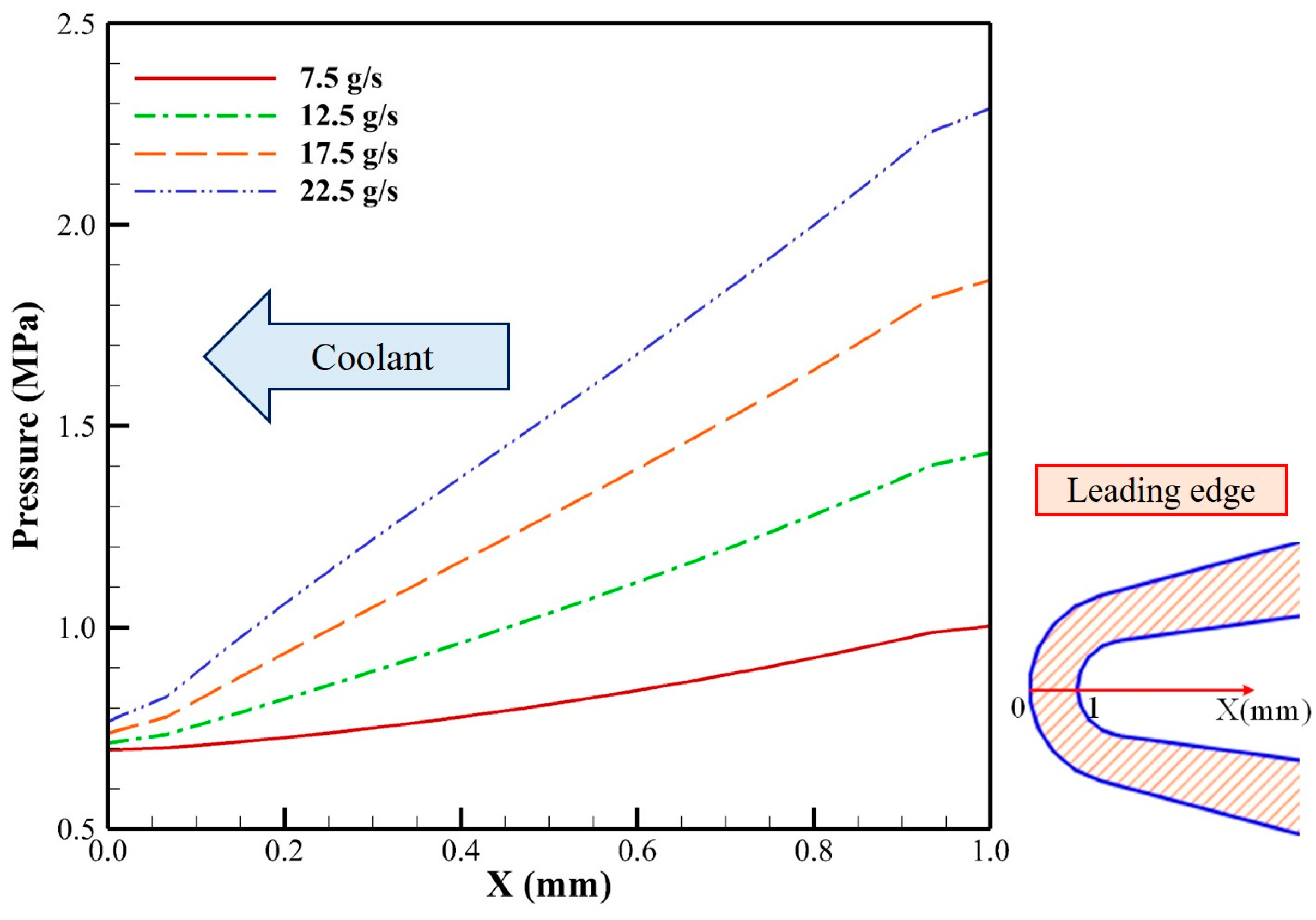
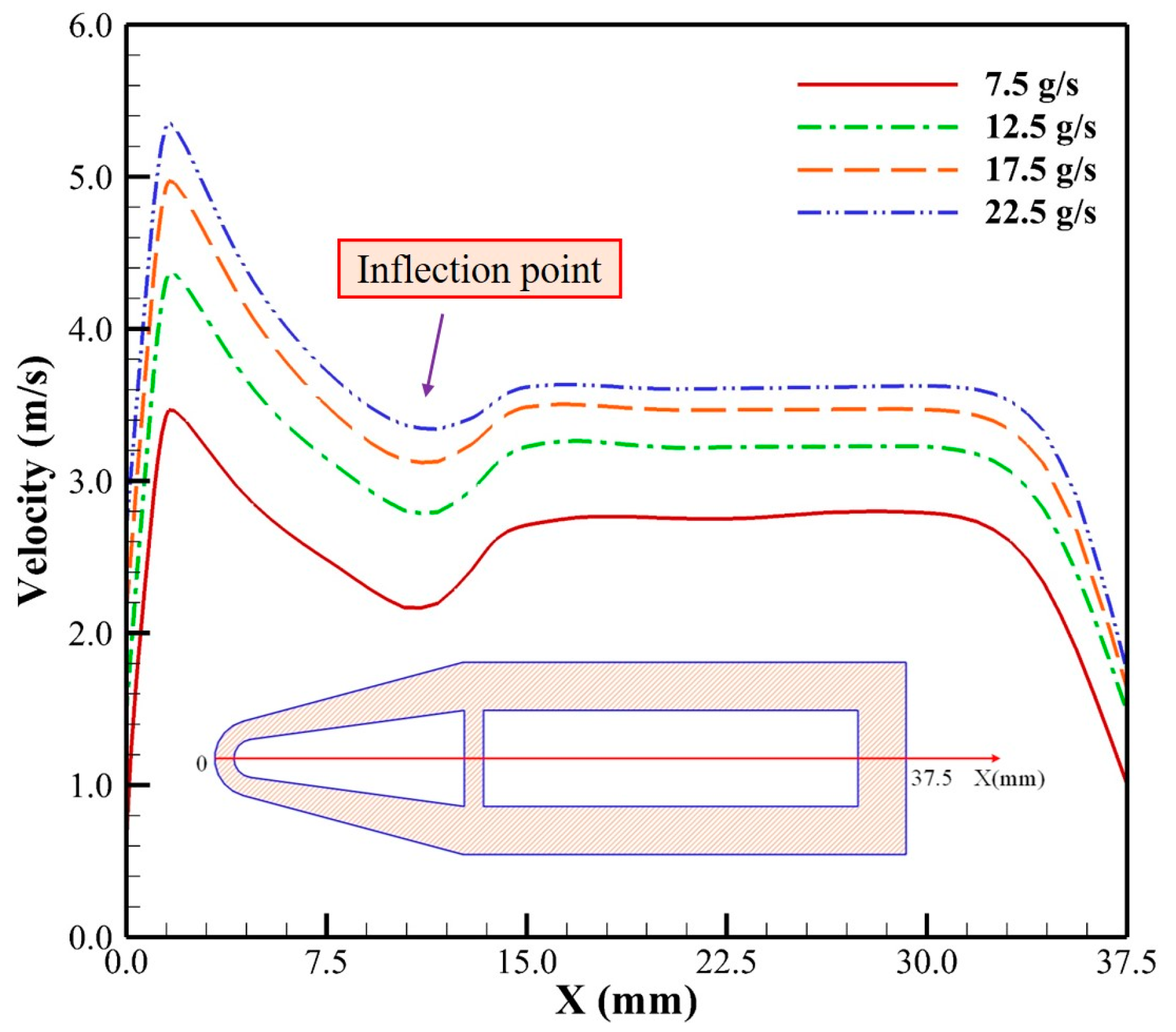
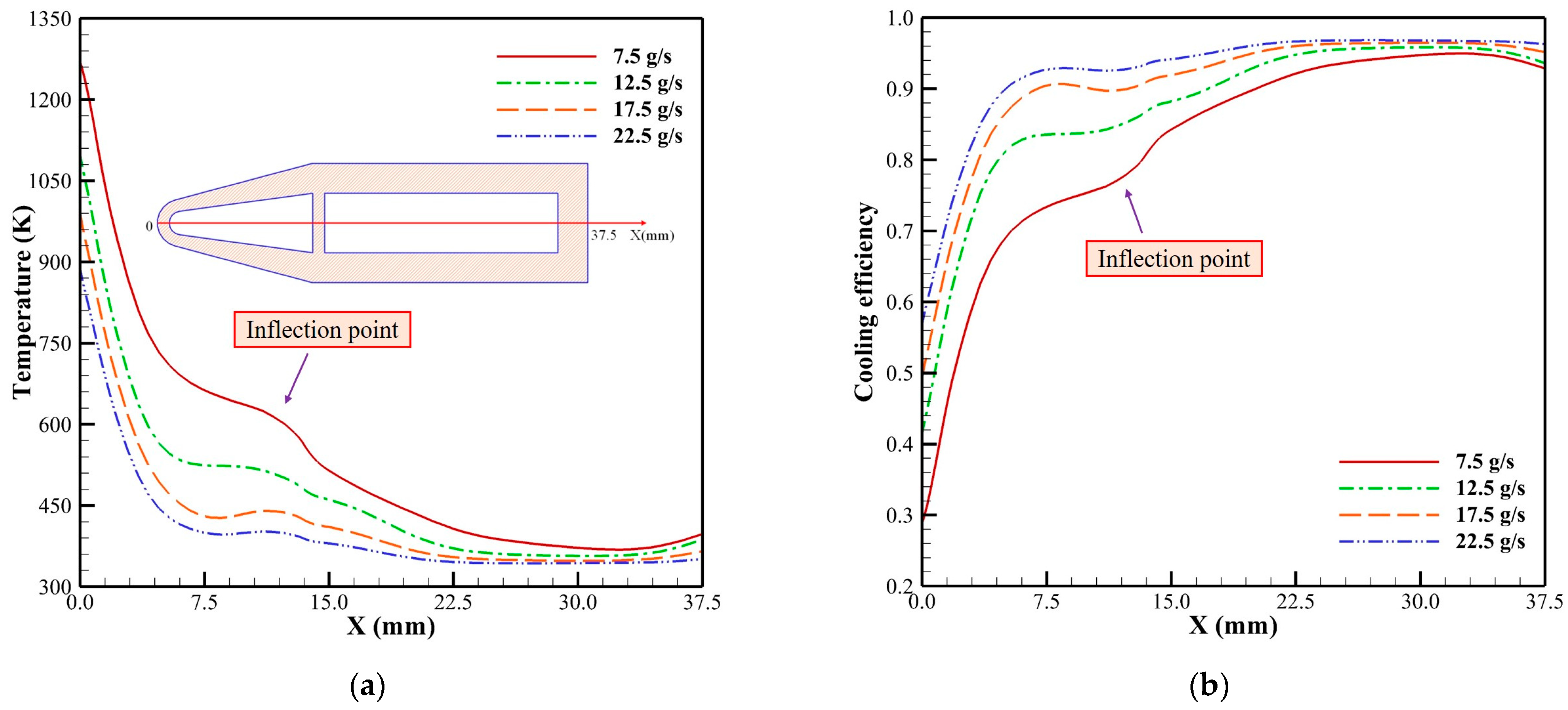
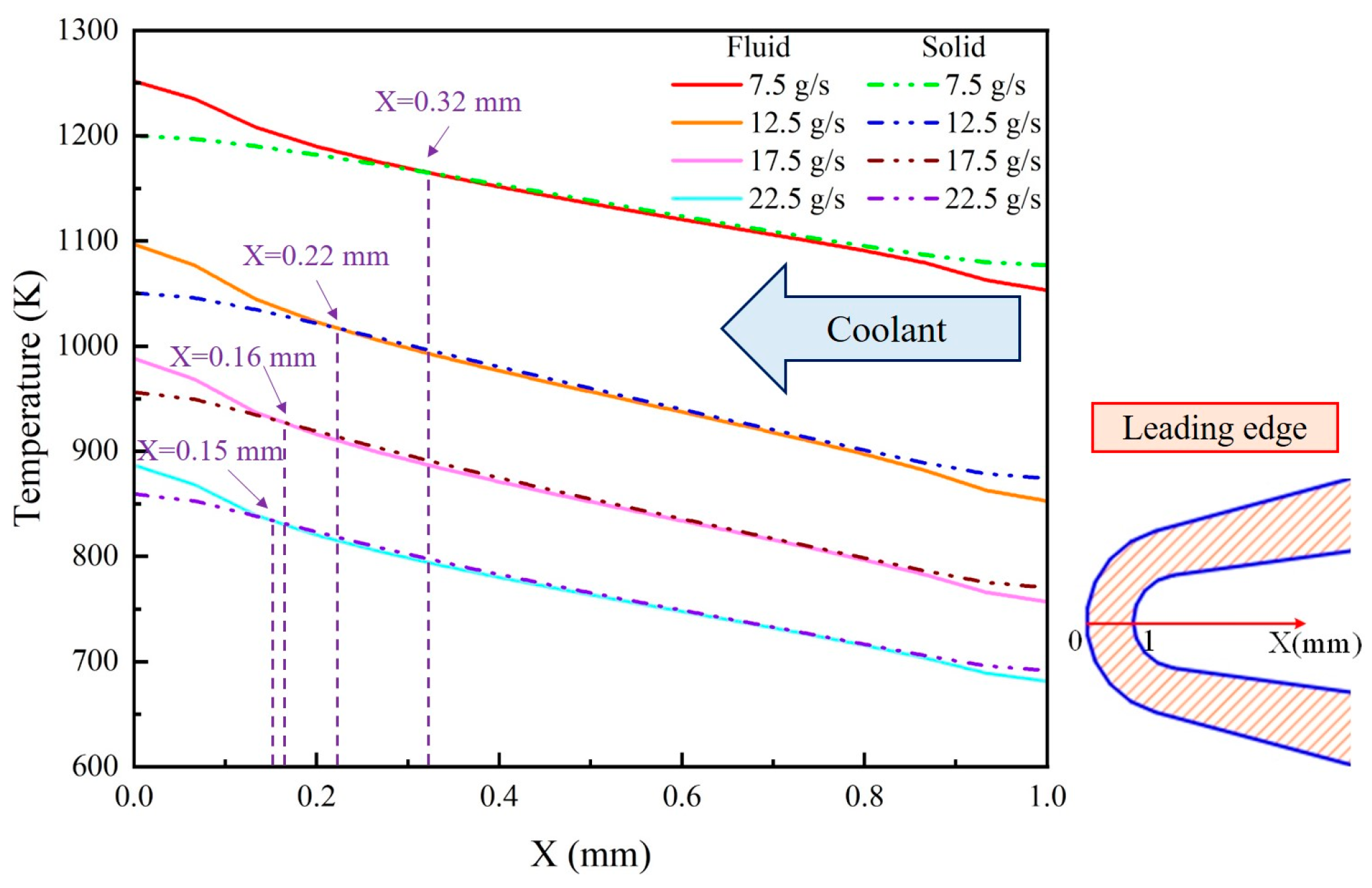
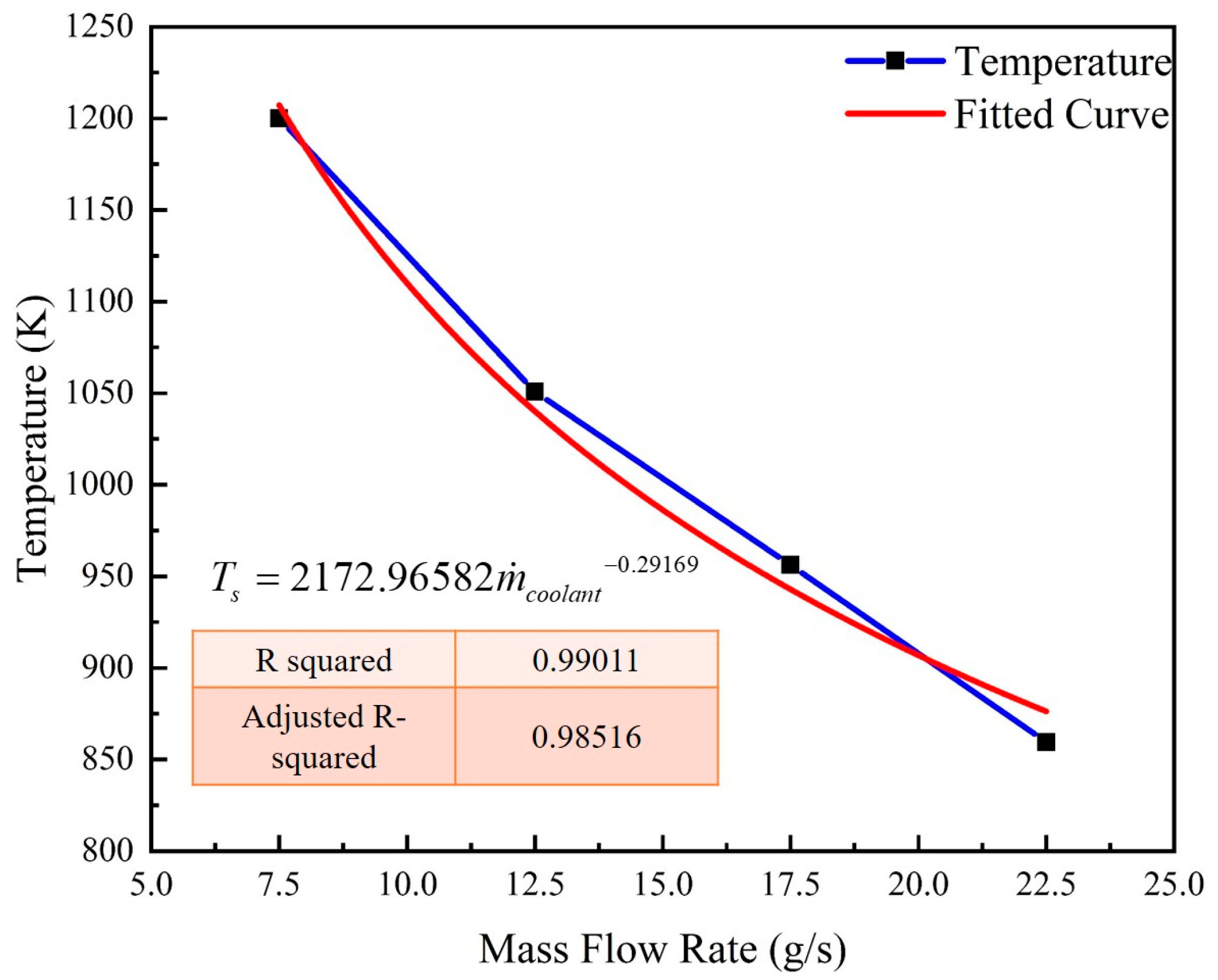


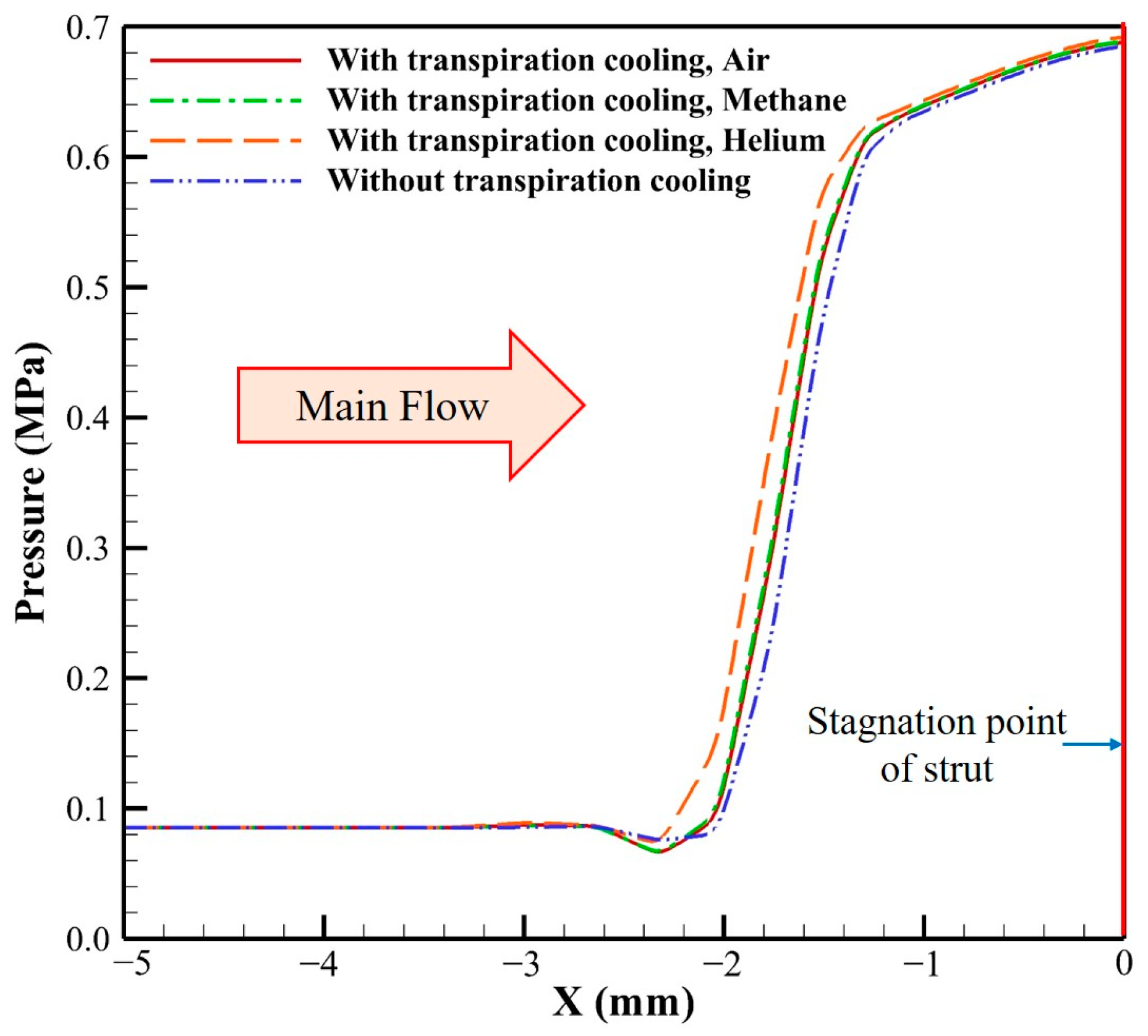

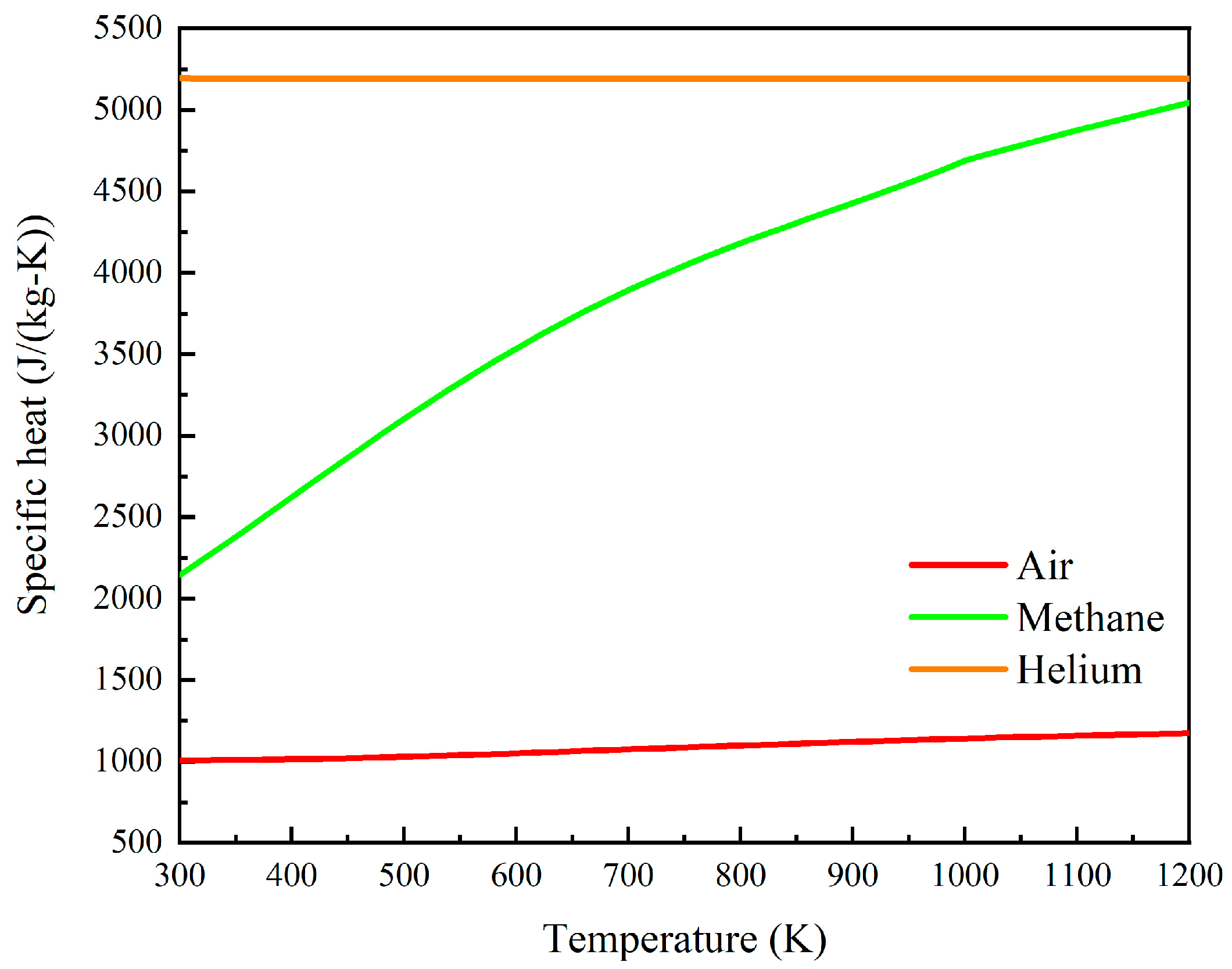
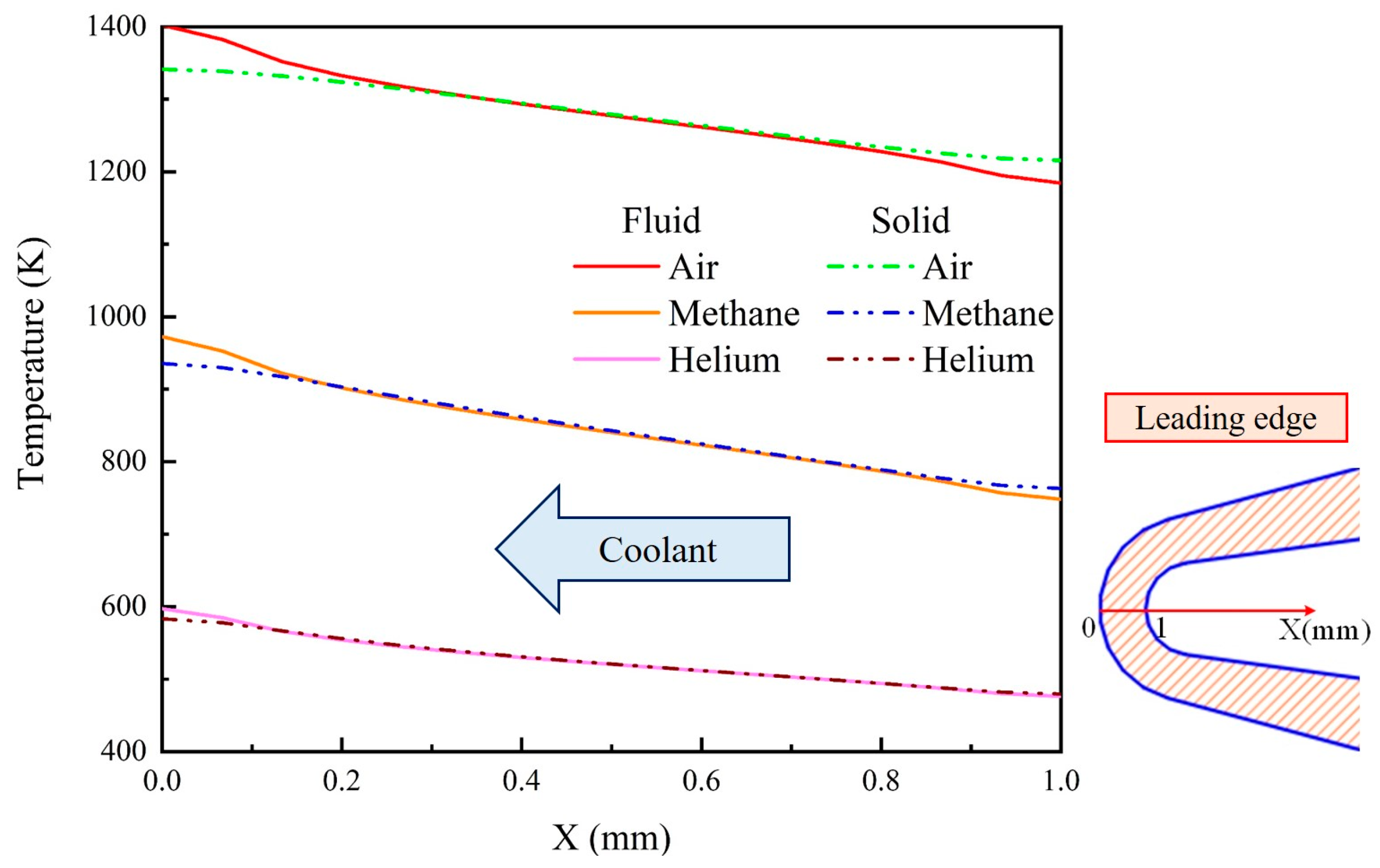
| Mesh | 1 | 2 | 3 |
|---|---|---|---|
| Number of grids (million) | 0.7 | 1.4 | 2.8 |
| Stagnation temperature (K) | 1675 | 1491 | 1502 |
| Calculation time (h) | 25 | 42 | 70 |
| Relative Position (x/L) | Experiment Temperature (K) | Numerical Simulation | |||
|---|---|---|---|---|---|
| LTE | LTNE | ||||
| Temperature (K) | Relative Error (%) | Temperature (K) | Relative Error (%) | ||
| 0.4 | 437.4 | 382.5 | 12.6 | 461.7 | 5.6 |
| 0.9 | 306.3 | 367.0 | 19.8 | 348.3 | 13.7 |
| 1.0 | 349.9 | 365.2 | 4.4 | 347.7 | 0.6 |
Publisher’s Note: MDPI stays neutral with regard to jurisdictional claims in published maps and institutional affiliations. |
© 2022 by the authors. Licensee MDPI, Basel, Switzerland. This article is an open access article distributed under the terms and conditions of the Creative Commons Attribution (CC BY) license (https://creativecommons.org/licenses/by/4.0/).
Share and Cite
Yang, H.; Liu, X.; Bian, Y.; Wang, G. Numerical Investigation on the Mechanism of Transpiration Cooling for Porous Struts Based on Local Thermal Non-Equilibrium Model. Energies 2022, 15, 2091. https://doi.org/10.3390/en15062091
Yang H, Liu X, Bian Y, Wang G. Numerical Investigation on the Mechanism of Transpiration Cooling for Porous Struts Based on Local Thermal Non-Equilibrium Model. Energies. 2022; 15(6):2091. https://doi.org/10.3390/en15062091
Chicago/Turabian StyleYang, Haiwei, Xue Liu, Yuyang Bian, and Ge Wang. 2022. "Numerical Investigation on the Mechanism of Transpiration Cooling for Porous Struts Based on Local Thermal Non-Equilibrium Model" Energies 15, no. 6: 2091. https://doi.org/10.3390/en15062091
APA StyleYang, H., Liu, X., Bian, Y., & Wang, G. (2022). Numerical Investigation on the Mechanism of Transpiration Cooling for Porous Struts Based on Local Thermal Non-Equilibrium Model. Energies, 15(6), 2091. https://doi.org/10.3390/en15062091





